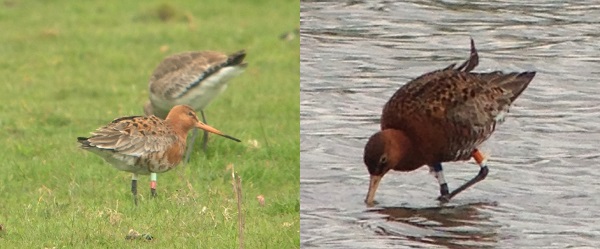Site menu:

July 2015 Newsletter
Species Spotlight - Arctic Terns.
Colour Ring Report.
June Bird News.
Forthcoming Events.
Latest Newsletter.
Species Spotlight - Arctic Terns

Long Distance Migrants
Arctic Terns have the longest migration in the animal kingdom, and you will know that, because they spend the breeding season in the northern summer and the non-breeding season in the southern summer, they see more daylight than any other animal. You will also probably have read that during their life times they can travel up to the equivalent distance to a round trip to the moon and back - three times.
Remarkable as all that is recent studies have shown that we have seriously underestimated just how far they do travel. In 2011 five Arctic Terns breeding in Holland were fitted with geolocators, and these were recovered the following summer (Ref 1). The journey they took was remarkable as shown on the map.
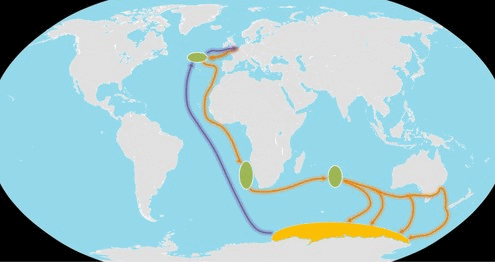
Annual migration route of Dutch Arctic
Terns as discovered by geolocators (Fijn et al/Ardea).
After leaving Holland in late July they
flew west to a staging area out in the northern mid-Atlantic where they
joined birds from Greenland and Iceland, this mid-Ocean staging area
was only discovered in 2007 during similar studies of Greenland and
Icelandic breeding Arctic Terns also fitted with geolocators. They then
flew south past the west coast of Africa before pausing off Namibia
then
flying round the tip of South Africa before reaching a previously
unknown staging area in the middle of the Indian Ocean. They then flew
south-east to spend the winter on the Antarctica coast south of
Australia, with one bird getting as far as New Zealand. So they flew
to Wilkes Land which is on the
far side of Antarctica from the south Atlantic! Total
flying distance from leaving Holland in the summer of 2011 and
returning the following spring was around 56,000 miles, compare
this with the circumference of the Earth which is 25,000 miles. Just
incredible.
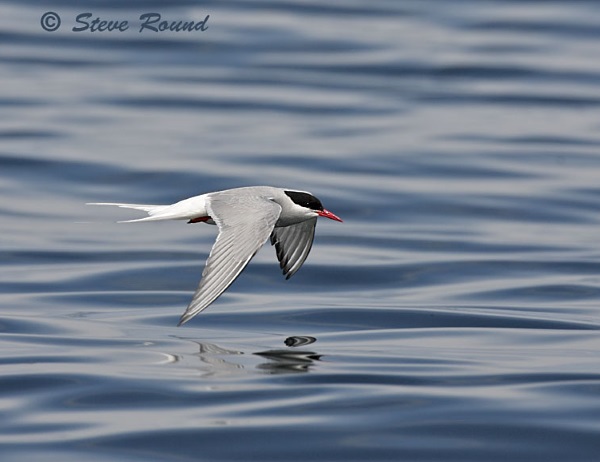
Arctic Terns Breeding in 'Greater' Liverpool Bay
I've rather extravagantly
called the square which has New Brighton in the southern
corner, the Isle of Man in the north, north Anglesey to the west and
Foulney Island to the east - 'Greater' Liverpool Bay. In that square we
have more Arctic Terns breeding then Common Terns and these
include the largest breeding colony of Arctic Terns in the
United Kingdom just 56 miles from Hilbre. This is on the
Skerries just off the north coast of Anglesey, the colony here has been
increasing steadily since the 1980's and reached an astounding 4,234
pairs in 2014. Pretty remarkable when you consider that the
large majority of Arctic Terns breed in the Northern Isles and
north-west of Scotland where numbers have been decreasing.
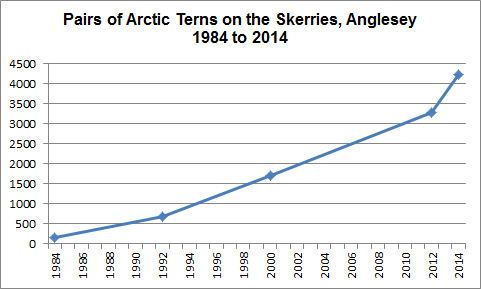
We also have several smaller colonies in this area, and these include (note numbers of breeding pairs can vary greatly from year to year): Cemlyn Bay with 40 pairs, Ribble marshes with unknown numbers breeding but some years could be at least 10 pairs, Isle of Man with 30 pairs, Foulney Island with 30 pairs.
It is unlikely that we see any of these birds here on the Dee estuary/North Wirral during the actual breeding season although immatures and failed breeders associated with the colonies may well wander along our coast. However, some of the birds we see before and after breeding may come from these colonies and this is discussed further below. But first, identification......
Arctic Tern Identification
It says in my New Naturalist book 'Terns' that Arctic Terns are "very easy to distinguish" from Common Terns. I have to admit it is an art that I have yet to master but that is because I'm lazy and I'm sure once you have learnt the differences between the species and given a bit of experience in the field then the authors of Terns are quite right. But they are talking about birds reasonably close to, especially those on the ground. A recent article in British Birds (Ref 6) points out that identification is much more difficult when the birds are flying at some distance and the author comments that flocks of terns seemed to be routinely identified as different species as they fly up the Severn Estuary, with one group of birders identifying them as Arctic and the next group identifying the same flock as Common, with the latter almost always correct.
Up until the late 1980s most birders didn't even attempt to differentiate between Arctic and Common Terns, calling them all 'Commic' Terns. Since then, as my 'Terns' book points out, it is now well documented that the two species do differ in many subtle ways. It has, perhaps, now gone too far the other way with birders over confident when trying to differentiate Arctic and Common Terns and not willing to call them 'Commic' as that would be an admission of failure. Nevertheless, any experienced birder having good and reasonably close views should have no trouble telling the two species apart.
Anyway, the point of all this is that the correct identification of Arctic Terns does appear to be an issue here in the Dee Estuary and North Wirral with the majority of reports in July and August greeted with scepticism by some. Recent Lancashire Bird Reports suggest similar problems with birds off Formby Point during July and August with the following being a typical quote (2012 Bird Report) - 'One group of experienced observers reported sightings from Formby Point on seven dates...including 55 on July 18th, while another regular sea-watcher at nearby Cabin Hill reported just one sub-adult on July 9th'.
Nevertheless, as the next section shows, there is no reason why we shouldn't be seeing Arctic Terns here on the Dee estuary in late July and August so we have to take reports at face value whilst still being aware of the identification difficulties.
For those, like me, who are not sure how to tell them apart then there are many sources on the internet to help you with the BTO Video on this subject (click here) one of the best.
Migrating Arctic Terns off the Dee Estuary and North Wirral
Just to the north of us a major spring passage of Arctic Terns is monitored every year by Heysham Bird Observatory and three-figure daily totals from mid-April into May are commonplace there. Max counts are usually around the 400 to 500 mark but 2011, to quote the Lancashire Bird Report, was 'phenomenal' with a total of 14,157 birds counted and the max count an amazing 8,153 on May 3rd. Sight observations strongly suggest that these birds gain height in the evening before heading north-east, so presumably crossing the country to the North Sea over-night; it therefore seems likely that these birds are part of the very large population breeding in Scandinavia and Baltic States.
The
birds we get here on the Dee estuary in spring are probably part of
this same movement but
much smaller numbers are involved with a total of just 12
double-figure
counts in April and May for the years 2005 to 2013. The first graph
below shows the totals for those years in 10 day periods during April
to
October for the Dee Estuary and North Wirral. The second graph is for
Dungeness over a similar time period, Dungeness is located at the
narrowest point of the English Channel and is a prime site for studying
the migration of Arctic Terns and it is interesting to compare the two.
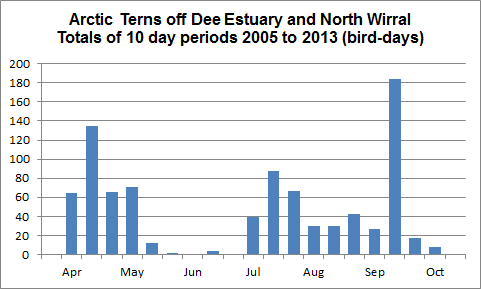
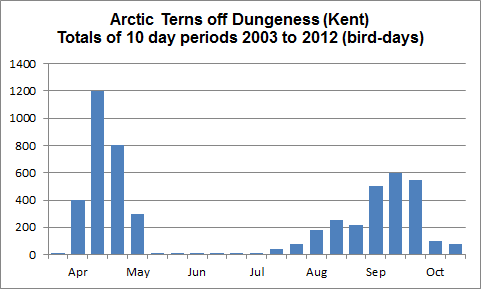
Both the spring and autumn peaks occur in the same period at both sites, in the last third of April and the last third of September respectively - and these birds may well be the ones flying to and from colonies in Scotland, Scandinavia and other parts of northern Europe. For the return migration at Dungeness numbers start to pick up through August before increasing further in September. On the Dee estuary we also get a few birds in August (remember the graph is showing totals over a nine year period so only very small numbers are involved at any one time), they can be hard to find with many recorded off Hilbre and the far edge of East Hoyle Bank rather than the main roost site at Hoylake.
Fijn et al., in their article about Arctic Terns fitted with geolocators, describe how the birds left the Dutch colony in the first week of July but then stayed in the North Sea region in relative close proximity to the colony, before moving on at the end of July. If birds in the 'Greater Liverpool Bay' colonies are doing the same thing this would neatly explain why we see a summer peak of numbers in the second half of July whilst birds are staying in the general area for a couple of weeks - remember over 4,000 pairs are breeding just 56 miles from the Dee estuary. This is in contrast to Dungeness where the nearest colonies are several hundred miles to the north and consequently counts in July are very low. Fijn et al. also found that two of the five birds which they were tracking left the North Sea by crossing the UK into the Irish Sea, proof that birds from colonies to the east of us do find their way into the Irish sea in summer and therefore could be observed from our shores. Other indications that many Arctic Terns in the Irish Sea post-breeding originate from the North Sea and the Baltic States come from ring recoveries at Dublin Bay; here they see Arctic Terns regularly staging with Common Terns in August, usually in quite small numbers but occasionally in their thousands.
I expect
we would be amazed at the number of Arctic Terns that actually pass
through the Irish Sea on migration if only we could track them all -
unfortunately most are way out to sea, fly over at great height or
migrate at night. But we are lucky enough to see a few here on
the
Dee estuary every year; most of the time they are vastly
outnumbered by Common Terns and easily confused with them by the
unwary. But when you do get a good view and are certain of the
identification it is an awe inspiring sight knowing the immense
distances they travel.
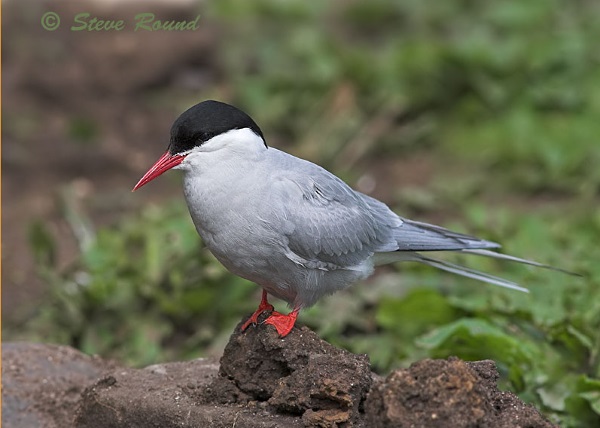
Sources of Information for this article.
1. Fijn R.C., Hiemstra D., Phillips R.A. & van der Winden J. 2013. Arctic Terns Sterna paradisaea from The Netherlands migrate record distances across three oceans to Wilkes Land, East Antarctica. Ardea 101: 3–12
2. Egevang C., Stenhouse I.J., Phillips R.A., Petersen A., Fox J.W. &Silk J.R.D. 2010. Tracking of Arctic terns Sterna paradisaea reveals longest animal migration. PNAS 107: 2078–2081.
3. http://www.arctictern.info/.
4. Welsh Onithological Society,
National Conference 2012:
http://www.birdsinwales.org.uk/activities/conference12.htm
6. Keith Vinicombe, The migration of Common and Arctic Terns in southern England, British Birds 107. April 2014 (data for Dungeness graph taken from this article, original data courtesy of Dungeness Bird Observatory - http://www.dungenessbirdobservatory.org.uk/).
7. DEFA's Biodiversity News, July 2014.8. Swn y Mor, Anglesey AONB Newsletter, Issue 16, 2015.
9. Roger Lovegrove, Graham Williams and Iolo Williams, Birds in Wales, Poyser, 2010.
10. Lancashire Bird Reports 2001 to 2013.
11. Cheshire and Wirral Bird Reports 2001 to 2013, CAWOS.
Richard SmithColour Ring Report
Spanish ringed Black-tailed Godwits, or even ones recorded in Spain, are quite rare here on the Dee estuary but we have seen three over the past few weeks on their way to Iceland, these include 'Tirns', which featured in the June Newsletter, with details of the other two shown below along with one of our more regular birds.
As mentioned elsewhere in this newsletter there was a late passage of small waders with unusually high numbers of Sanderling in early June - it is very likely that all these Sanderlings will have over-wintered in Mauritania, west Africa, and the two ringed ones we saw both came from there.
Black-tailed Godwits
WN-LR ringed in north-west Iceland on June 22nd 2003.Recorded at Gilroy Nature Park, West Kirby, on several dates during April 2015, last record 25th.
Seen in southern Ireland in January 2005 then at Seaforth NR in August in both 2007 and 2008, and again there in Aug 2012.
It was recorded in Iceland during the breeding season in 2008, 2012 and 2013.
First seen in the Dee estuary area in April 2013 when it was at Thurstaston and Caldy, and in April 2014 it was at Gilroy Nature Park then both there and Thurstaston in September and October 2014.
Apart from two Irish records all sightings have been during migration or in Iceland.
OWflag-BW ringed in Extremadura, Spain, on February 2nd 2015.
Recorded at Burton Mere Wetlands on May 7th and 8th 2015.
Also seen near Galisteo, Spain, on March 9th 2015.
RR-OO ringed in southern Iceland on June 19th 2001.
Recorded at Burton Mere Wetlands on April 12th 2015.
Seen in Iceland during the breeding season in 2002, 2003, 2004 and 2005.
Spent winter in Portugal in 04/05, 05/06, 06/07 and 07/08.
Visited Brittany during migration in the autumn of 2006 and 2007.
April 2008 saw it at Caerlaverock, Scotland, and in March 2013 it was at Maldon in Essex.
First recorded in Spain, in Extremadura, in February 2010 and again in February 2011. October 2011 saw it in Cota Donana, Spain.
Since visiting Caerlaverock in 2008 there have only been six sightings of this bird including the BMW record this April.
Sanderlings
W4RGGW ringed in Iwik village, Banc d'Arguin, Mauritania, on December 6th 2007.Recorded at Hoylake on June 2nd 2015.
Also seen at Portbail, Cherbourg Peninsula, France, on August 14th 2013.
W5WR?? right leg NOT seen (hence '??') but we know from left leg flag and rings that it was ringed in Mauritania on December 1st 2009, one of 10 with that combination.
Recorded at Hoylake on June 2nd 2015.
Richard Smith and Matt Thomas.
Colour-ringed birds were also recorded by John Jakeman, Manu Santa-Cruz and Chris Tynan.
Top of Page
June Bird News
June is always a quiet month and this year was no exception, but there was still plenty of interest. Rarities included a Caspian Gull at Hoylake on the 1st and a female Red-necked Phalarope at Burton Mere Wetlands on the 2nd and 3rd, then surprisingly it, or another, was present on the 15th. The 26th brought a Serin to Meols and a Ring-billed Gull to Burton Mere Wetlands.
Dark-bellied Brent Geese are certainly a rarity in June and what one was doing at Burton Mere Wetlands on June 28th I'm not sure, a male Pochard there was also unexpected and was initially mistaken for something much rarer! A flock of 10 Eiders, nine of which were drakes, were off Hilbre on the 4th.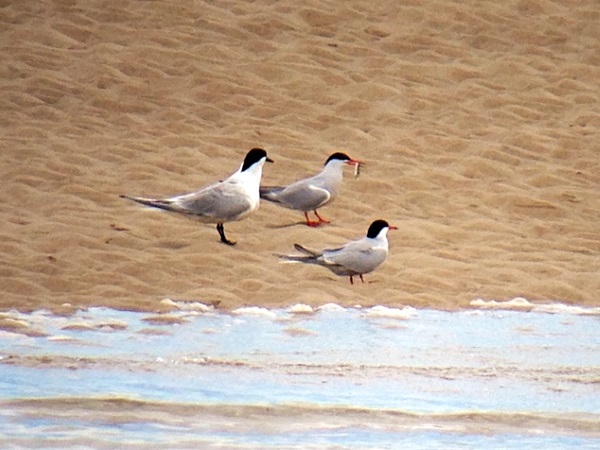
© Steve Williams, Hilbre Bird Observatory.
The late cold spring resulted in a notable late passage of small waders, particularly Sanderlings with 350 on Hoylake shore on the 2nd and still 176 on Hilbre on the 6th. Because of colour ringing we knew exactly where these Sanderlings had spent the winter - Mauritania. A Wood Sandpiper at Burton Mere Wetlands in the second week of June was either a very early returning bird or, perhaps more likely, a failed breeder. The first Common Sandpiper was early with one at Burton Mere Wetlands on the 12th. Spotted Redshanks, Greenshanks and Whimbrels were all seen by the month-end and there was a noticeable build up of Curlews and Redshanks. A few over-summering non-breeding waders were present including Grey Plovers, Oystercatchers, Knots and Bar-tailed Godwits.
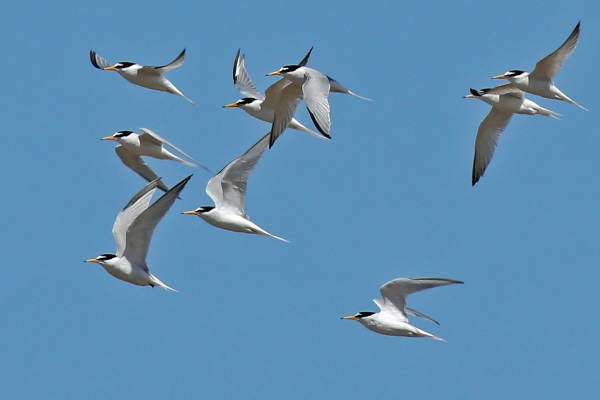
There were 320 adults and 14 chicks counted at the Gronant Little Tern colony by the end of June, that is a very high count of adults and presumably includes a fair number of immature birds. They've had at least 106 nests there and are hoping for a record of 150 fledglings this year - that would be a fantastic total. See https://www.facebook.com/gronantlittleterns. It's not too late to volunteer to help keep the Kestrel away!
Flocks of gulls built up through the month and included several records of Mediterranean Gulls with the adults looking magnificent in their breeding plumage.
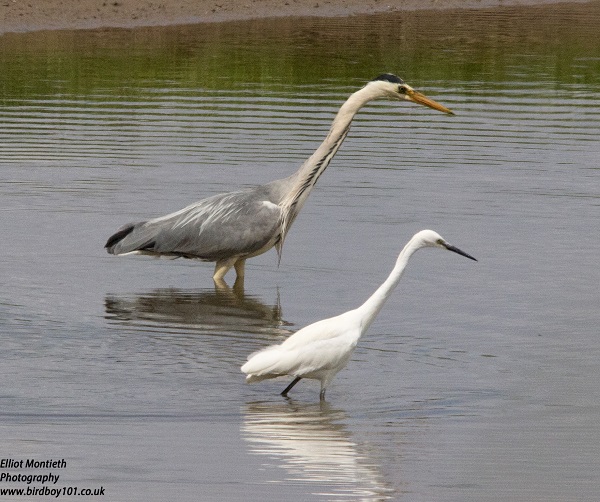
www.birdboy101.co.uk/
Richard Smith.
What to expect in July
Out to sea we will see Gannets and Manx Shearwaters, especially during a strong westerly, and some years we get Storm Petrels as well, although always difficult to see in the waves. Recent research suggests that Storm Petrels travel further from their breeding sites than previously thought so the birds we see in July may well come from colonies such as on Bardsey Island, although there is also evidence that non-breeding immature birds move through the Irish Sea during the summer.
Wader numbers will increase substantially through the month - particularly Curlew and Redshank. Greenshank, Spotted Redshank, Common Sandpiper and Green Sandpiper will also be passing through. Look out for Greenshank and Spotted Redshank at Parkgate, and all four species should be seen at Burton Mere Wetlands and Connah's Quay. Common Sandpipers can turn up just about anywhere including Hilbre.
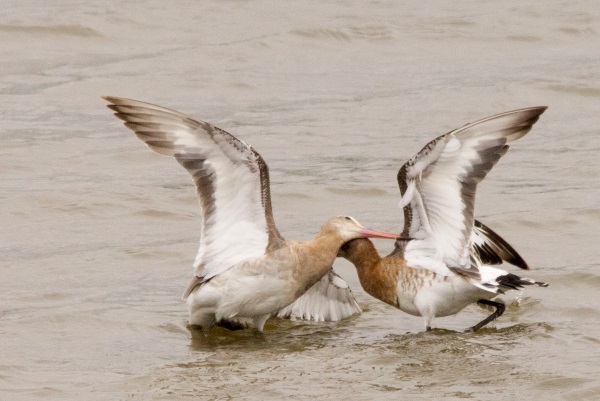
www.birdboy101.co.uk/
Top of Page
Forthcoming Events
July Highest Spring Tides (Liverpool)
Also
see Tides
page.
3rd July, 12.47hrs (BST), 9.2m.
4th July, 13.31hrs (BST), 9.3m.
5th July, 14.17hrs (BST), 9.3m.
Forthcoming Events
Organised by the Wirral
Ranger Service , Flintshire
Countryside Service and the
RSPB (Dee Estuary):
All these events and walks have bird interest, even those not
advertised specifically for birdwatching. No need to book for these
events unless specified - please check below.
Also see 2015 Events Diary.
Join the Ranger on this evening stroll and discover where bats and owls live and hunt.
Meet at the Court Yard/Coach House at Royden Park.
Wind/waterproof clothing and stout footwear are essential. Sorry no dogs.
Number's are limited, Booking Essential.
Telephone:
0151 677 7594.
Saturday 25th July, 10:30am - 3:30pm, Owl Workshop in the Coach House - Royden Park.
Join the Wirral Barn Owl Trust on this Owl workshop in the Coach House and identify the different owl pellets and other interesting facts about owls.
Meet at the Court Yard/Coach House at Royden Park.
The Tea Servery is open for refreshments.
Sorry no dogs.
Telephone:
0151 677 7594.
Saturday 8th August, Big Wild Sleepout at RSPB Burton Mere Wetlands.
5.30 pm Saturday to 9 am Sunday
Price: £30 per person (£25 RSPB members); £15 under-14s (£12.50 members)
Back for it's third year, Burton Mere Wetlands' biggest and best family event, is the Big Wild Sleepout 2015.
For one night only, we’re giving families the chance to camp out in the wilderness at one of the best wetlands in the North West.
Join us for exciting evening activities including moth trapping and bat watching, and uncover the secrets of Burton Mere Wetlands' nocturnal wildlife.
Dinner and a light breakfast are provided, and hot and cold drinking water is available on site along with a range of snacks, but bring along any other nibbles and drinks for the evening. Indoor toilet facilities are provided on site.
This fantastic summer sleepout experience will be held overnight on Saturday 8 August. For more information and to book on the event – please call the reserve on 0151 353 8478 or email deeestuary@rspb.org.uk .
Payment in advance is essential
